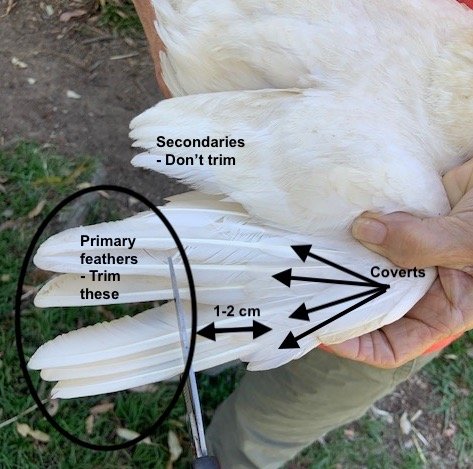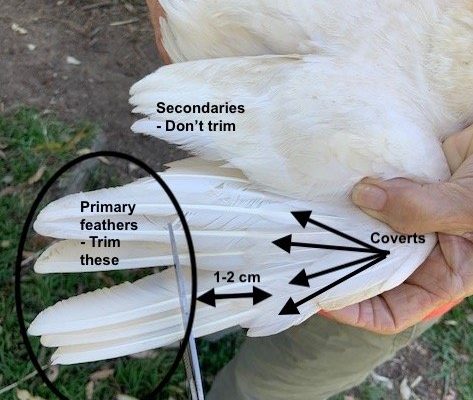
Clipping a chicken’s wings isn’t about stifling their spirit or trying to control them. It’s more about keeping them safe and secure. Think of it as giving them a little haircut to prevent them from taking flight too far. With that said, it’s essential to understand both the reasons behind this practice and how to do it safely. Let’s dive into what it means to clip a chicken’s wings, how it works, and if it’s the right decision for you and your feathered friends.
Understanding Wing Clipping
So, what exactly is wing clipping? Basically, it’s the process of trimming the primary wing feathers on one side of a chicken to prevent them from flying well. Chickens, by nature, don’t fly like eagles, but they can still clear a fence or two if they feel motivated. When you clip their wings, you’re simply helping to reduce that flight capability.
Clipping does not hurt the chicken when done properly. It’s a bit like trimming your nails—uncomfortable if done incorrectly, but a necessary task that can prevent bigger issues. With the right techniques, you can keep your chickens grounded without causing them pain or fear.
Now, I know what you might be thinking—doesn’t that sound a bit harsh? Here’s the thing: keeping chickens usually comes with the responsibility of creating a safe environment. If your coop or yard isn’t completely escape-proof, wing clipping can be a practical way to keep your chickens from wandering off into trouble, like getting lost or encountering predators.
Reasons for Clipping Wings
You might still be wondering, “Why should I even consider clipping my chicken’s wings?” There are several good reasons, and each one contributes to their overall safety and well-being.
- Preventing Escapes: Young chickens and active breeds love to explore. Clipping wings can help reduce the chances of them flying out of the coop.
- Avoiding Predators: Chickens that fly often can attract unwanted attention from predators. Keeping them grounded helps keep them safe.
- Minimizing Injuries: Flying can lead to accidents, like crashes into fences or other structures. By clipping their wings, you can help prevent painful injuries.
Let’s break this down further: Imagine your adventurous chicken, let’s call her Daisy. Daisy sees something shiny on the other side of the fence. If she can easily fly over, she’s off on an adventure but could land right in danger’s path. By clipping her wings, you’re essentially setting boundaries that keep Daisy happy and safe in her environment.
How to Clip Chicken Wings Safely
If you decide that wing clipping is the right choice for your chickens, you might be curious about the actual process. Clipping wings is pretty straightforward, but it’s important to do it correctly to ensure your chickens remain comfortable and healthy.
1. Choose the Right Time: Pick a time when your chickens are calm, like during the late afternoon or when they’re being fed. Less excitement means less squawking!
2. Gather Your Tools: All you need is a pair of sharp scissors or poultry shears. Make sure they’re clean and sharp to avoid any accidents.
3. Locate the Feathers: Focus on the primary feathers—these are the longest ones in the wing. You want to avoid cutting into the wing’s skin or the blood feathers, which are still developing.
4. Make the Cut: Trim about half of the primary feathers on one wing. This uneven cutting ensures they can’t get enough lift to fly.
Always remember to handle your chickens gently and calmly during this process. If they seem stressed, take a break and try again later.
Post-Clipping Care
Once you’ve clipped your chickens’ wings, there are a few things to keep in mind. While they may seem a bit off-balance for a short while, they’ll adjust quickly. Here’s how to help them settle in:
– Observe Their Behavior: After clipping, keep an eye on your flock. They might squawk a bit or try to flapping their wings, but don’t be alarmed. It’s all part of the adjustment period.
– Provide Adequate Space: Make sure their living area is spacious enough. Even grounded chickens need room to roam and explore safely.
– Monitor for Injuries: Occasionally check their wings for any signs of distress or injury. If you notice anything amiss, consult a vet.
Just like people need time to adjust after a haircut, your chickens will also need time to get used to their clipped wings.
Alternatives to Wing Clipping
If you’re still not sure about clipping wings, there are alternatives worth considering. Not every chicken owner feels this is necessary, and there are ways to keep your birds safe without taking to their feathers with scissors.
– Secure Fencing: Consider building higher fences or adding netting over the top of your coop. This creates a safe environment without clipping.
– Supervision: When letting them roam, supervise their outdoor time. This can help you keep them safe from predators and prevent escapes.
– Enrichment: Providing plenty of entertainment can keep chickens busy and less likely to explore beyond their safe space. Think toys, dust baths, and foraging opportunities.
Choosing not to clip can be a personal decision rooted in your relationship with your chickens. If they’re content in their environment and there’s little risk of escaping or danger, you might opt to let them keep their wings intact.
In the end, whether or not to clip a chicken’s wings is a personal choice based on your specific situation. It’s all about weighing the benefits of safety against the desire for freedom. If the thought of your little feathered friends flying away into a neighbor’s yard or worse, into a predator’s path, makes you uneasy, then wing clipping could be a sensible option.
On the flip side, if you have a secure, predator-free environment, you might feel a little more comfortable letting your chickens fly—just a little! Whatever you decide, the most important thing is to ensure your chickens are safe, happy, and healthy. They rely on you for protection and stewardship, so choose what feels right for you and your flock. Happy chicken-keeping!

